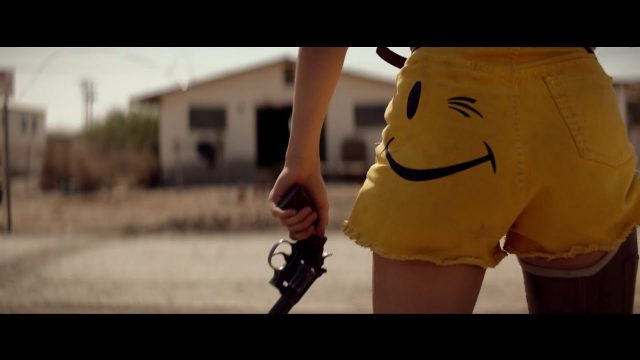Ana Lily Amirpour exploded onto the indie horror scene with her debut feature A Girl Walks Home Alone At Night. A sinister methodically paced black and white vampire movie, A Girl Walks Home was something of a hybrid between early Jim Jarmusch and a genre-obsessed Ingmar Bergman. Though Ms. Amirpour was born in California and her movie was made in California, her choice to use the Persian language highlighted the exoticism of this foreign-to-America examination of the intersection of the Muslim faith and pop culture modernity.
That’s nothing like The Bad Batch.
If one could compare A Girl Walks Home Alone At Night to Jim Jarmusch, The Bad Batch is closer to 1980s Ozploitation, but with a decidedly more gorgeously nihilistic edge to it. In the dystopian future, America no longer maintains prisons, having replaced them with border walls to keep the good people in and the bad people out. If a citizen is found guilty of a crime, they’re tattooed and banished from the country. These poor saps are left to fend for themselves in the harsh and unforgiving desert where people have formed dysfunctional communities and resorted to cannibalism to stay alive.
It’s in that setting that we’re introduced to Arlen (Suki Waterhouse), a young innocent-looking white girl who’s been banished from America before the credits have even finished rolling. There are no goals except survival, the one impulse that connects everybody in this vast wasteland. From the thong-wearing bodybuilding cannibal community that kidnaps her for dinner to the peaceful hippy-esque community of Comfort with a crazy cult leader of its own, virtually everybody is out for one thing: themselves. In order to survive, Arlen has to make a place for herself while still managing to keep a hold of her own sense of self.
If this sounds like the plot for a 1980s Cannon Film or some Australian pseudo-western like Mad Max or Dead-End Drive In, you’re on the right track. Amirpour’s story is a hazy drifting Fallout-style tale of two cities and the interloper who changes things just by introducing herself into the situation. Unlike the Ozploitation movies of old, this is no easy experience. The Bad Batch is defined by its sadistic violence, unflinching cruelty, and pitch black humor. Within the first fifteen minutes, Arlen is trapped, dismembered, and kept alive so the meat stays fresh for multiple days while a group of cannibals feast on the arm and leg they sawed off to the tune of Ace of Base’s All That She Wants.
Throughout the unrelenting cruelty, there’s a sense that Amirpour loves and loathes everything within the frame of the movie. Her characters aren’t single dimensional monsters who have the universal goal of loving or killing the protagonist. Miami Man (Jason Momoa) takes the time to draw a cute but amateur portrait of his daughter before brutally killing another victim for food, a testament that he knows how to desire and yet he must feed to stay alive.
The stratification and separation within this rebel society strains to recall our own societal ills. Comfort even has a megalomaniac who leads the city from behind closed doors. But, it comes off a little too pat, a little too easy, and a little too inspired by video games to ever reach deep into the morass of our depraved American subconscious. Amirpour has the ability to create lush visual depictions of cruelty, daring us to say that this is the post-Trump humanity that we fear, but hasn’t quite figured out what it all means.
This came to a head last month when a black female viewer, at an advanced screening in Chicago asked Amirpour what she meant by having Arlen, a white woman, assassinate a black woman (one of her former captors) by shooting her in the head in front of the woman’s child, whom Arlen then adopts. For much of the movie, the gruesome violence was well within the fantasy iconography of action movie or horror, including the image of the black woman helping to consume human flesh . But, this shooting mimicked the power imbalance of real world white-on-black shootings, especially given Arlen’s adoption of this woman’s child. And yet, Amirpour had no ready answer and dismissed the concerns about real-world analogues.
The Bad Batch isn’t a typical bubble-headed post-apocalyptic western genre exercise soaked in nostalgia, but it also isn’t as fully baked as it needs to be to sustain its nearly 2 hour run time. It’s a visually stunning, textural and graphic trip through genre territory that feels risky and dangerous again, remixing classic tropes in a distinctly post-Tarantino style without being beholden to the shallowness of nostalgia. Amirpour is beholden to the current onscreen emotions with distinctly feminine plot contrivances that many men will find to be shallow Harlequin tropisms. Yet, there’s something underdeveloped about her social commentary that she deliberately inserted into the movie despite not understanding the full ramifications of her actions. In a way, that simplicity almost fits in with the movie, where people act on their own behalf without fully understanding how their actions affect others. And yet, I hate to put it out there, this is not to be missed…with reservations.


